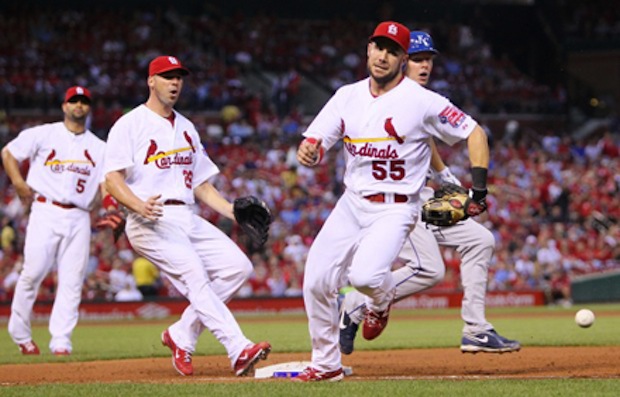
Every player on the field has a responsibility every time the ball is put in play – whether by batted ball, passed ball, or errant pickoff attempt. If you are a player you’ve heard it before, and if you are a coach you’ve said it before: “You need to backup a base!”
You Always Have a Place to Be
Baseball players are not merely spectators during a game. Whether playing in the field or sitting in the dugout, every player should be aware of the inning, number of outs, how many men are on base, the score, and numerous other situational factors. Whether he is in the starting lineup or not, a ballplayer can learn a great deal about the game by staying mentally involved and paying attention.
That being said, those ballplayers on the field should be even more in-tune with the game and the current situation. It’s very easy for an outfielder to lose his concentration as the pitcher is mowing down hitters. He may never have a ball hit to him, but that does not mean he should not be prepared for it. He needs to know what the situation is so if the ball is hit to him he can deliver it to the proper base in order to make an out or prevent a runner from advancing.
But what if the ball is put in play and the ball is hit to another part of the field? Does that outfielder have any other responsibility during that given play? YES!
There’s no reason for a pitcher to get mad and stand on the mound sulking when he gives up a double in the gap. The left fielder doesn’t need to take in the action as a base hit is lined to right. And the right fielder shouldn’t be hanging his head as an infielder makes a play on a routine ground ball. All of these players have a responsibility to back up a nearby base.
As the defensive team, you don’t want a big offensive play to become even bigger because an errant throw has no one to stop it. So, learn where you need to be in a given situation, and get there. You never know when backing up a base could save your team a run.
When Different Positions Should Back Up Bases
Pitcher
It’s pretty much a given that the pitcher will be backing up third base or home plate depending on the play. He should split the third base line and then back up third or home based on where the play develops. Furthermore, the pitcher should look to block any openings to dugouts (or other out of play areas) so as not to allow a runner to advance because of a dead ball.
Catcher
Catchers have it fairly easy. Usually, they need to stay at home and cover the plate. However, with nobody on base, many coaches teach their catcher to trail the batter if he hits a ground ball in the infield. This will allow him to chase down any errant throws that get by the first baseman.
First Baseman
With nobody on base, the 1st baseman should look to back up second base if a ball is hit into left or left center and the runner is looking to make it a double. Outside of this situation, the 1st baseman usually needs to stick around the infield as a cutoff man for balls hit into center or right. If he is not the cut off man, he can help back up home on possible scoring plays.
Second Baseman
The 2nd baseman is usually the back up man on a steal attempt where the shortstop is covering second base. He should also back up first base during bunt plays when the pitcher, catcher, or 3rd baseman is making the play.
Shortstop
Again, during a steal attempt where the 2nd baseman covers the base, the shortstop should back up. This is the same for steal attempts at 3rd base. If there is a runner on third, the shortstop should also make his way behind the pitcher when the catcher throws the ball back after a pitch. You never know when a catcher might be a little nervous and overthrow the pitcher.
Third Baseman
The 3rd baseman will usually only back up second base on a base hit to right field when there are no other runners on base. Though rare, the third baseman should also be aware of a wild throw from the 1st baseman to the pitcher after a pickoff attempt.
Left Fielder
The left fielder needs to back up second base on throws from the right fielder. He also should back up the shortstop and 3rd baseman when the catcher throws to 3rd base on a steal attempt. Furthermore, he should look to back up the center fielder on balls hit to center field.
Center Fielder
The center fielder needs to back up his fellow outfielders when the ball is hit to their respective fields. He is also another back up man for plays made at 2nd base.
Right Fielder
The right fielder needs to back up first base on ground ball plays in the infield, pick off attempts to first base, and bunt plays. He should back up the center fielder on balls hit to the center field, and he should back up second base on balls hit to left field when the left fielder throws it to second.
This is by no means an all inclusive list of where each position needs to be during a given situation. In any event, a good ballplayer will always find a place to be so that he can help his team if the situation calls for it.
What other situations can you think of where a player needs to back up a base?
Leave a Reply